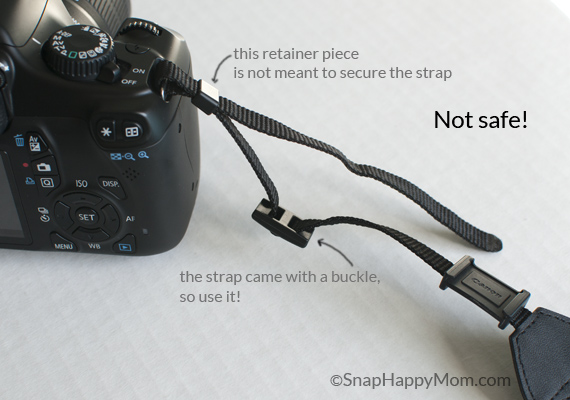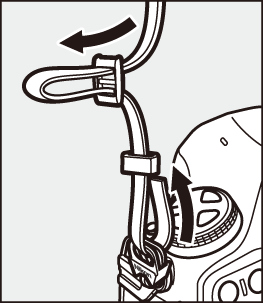To put a strap on a camera, thread the strap through the strap lugs on the camera body. When heading out on a photography adventure, ensuring your camera is secure and easily accessible is crucial.
One essential accessory for this is a camera strap. Attaching a camera strap may seem simple, but it is vital to do it correctly to avoid any mishaps. The process typically involves threading the strap through the designated strap lugs on the camera body.
This not only provides extra security but also gives you peace of mind while capturing those perfect shots. In this guide, we will walk you through the straightforward steps to properly put a strap on your camera, ensuring you are ready to take on any photographic challenge that comes your way.

Credit: snaphappymom.com
Choosing The Right Strap
When it comes to camera accessories, an often overlooked but essential item is the camera strap. A camera strap not only provides comfort while carrying your camera but also ensures the safety of your valuable equipment. However, with numerous options available in the market, choosing the right camera strap can be overwhelming. Here, we will discuss two important factors to consider when selecting a camera strap: your camera’s weight and size, and the type of strap that suits your needs.
Consider Your Camera’s Weight And Size
Before purchasing a camera strap, it is crucial to take into account the weight and size of your camera. Different cameras have varying dimensions and weights, ranging from compact point-and-shoot cameras to bulky DSLRs. The last thing you want is a strap that is too flimsy and uncomfortable for heavy equipment, or one that is overly robust and unnecessarily bulky for a lightweight camera.
Pro Tip: To determine the appropriate strap, check your camera’s specifications or reference the product manual for weight and size information.
To assist you in making an informed decision, let’s break down the most suitable straps for different camera weights and sizes:
For Compact Cameras
If you own a compact camera, a traditional neck strap or wrist strap is generally adequate. These straps provide convenience without adding unnecessary bulk. As compact cameras are lightweight, a simple strap made of nylon or fabric will ensure easy portability and comfort during use.
For Mirrorless Cameras
Mirrorless cameras are known for their smaller form factors yet sophisticated features. Generally, mirrorless cameras fall in the mid-weight range, requiring a strap that provides better support. Opt for a wider and padded strap to distribute the weight evenly across your body, reducing strain during prolonged use. A sling strap is also an excellent option, as it allows quick access to the camera while keeping it secure.
For DSLR Cameras
When it comes to DSLR cameras, a sturdy and reliable strap is essential due to their heavier weight. Look for a strap made of high-quality materials such as neoprene or ballistic nylon, along with reinforced stitching. Consider a wider strap with extra padding for added support and alleviation of the camera’s weight. Additionally, dual shoulder straps or a harness system can provide even distribution of the load, making it easier to carry your DSLR for hours on end.
Decide On The Type Of Strap
Now that you’ve determined the suitable strap based on your camera’s weight and size, the next step is deciding on the type of strap that aligns with your preferences and shooting style. While the traditional neck strap is the most common, there are alternative options to consider:
- Sling Strap: The sling strap offers the flexibility of shooting while the camera is hanging by your side. It allows you to quickly bring the camera to your eye for capturing those spontaneous moments.
- Wrist Strap: Ideal for photographers who prefer to have their camera securely attached to their wrist, the wrist strap provides ease of access and peace of mind, especially in fast-paced shooting scenarios.
- Shoulder Strap: If you frequently shoot for extended periods, a shoulder strap is an excellent choice as it distributes the weight across your shoulder and upper back, reducing strain on your neck.
- Harness Strap: Designed for serious photographers or those carrying heavier camera setups, a harness strap evenly distributes weight across the upper body, providing maximum support and enhancing stability while shooting.
Remember: It is essential to try different types of straps and consider personal comfort and shooting preferences before making a final decision.

Credit: m.youtube.com
Attaching The Strap To Your Camera
Attaching the strap to your camera is an essential step to ensure the safety and security of your equipment, especially when you’re out and about capturing unforgettable moments. By properly attaching the strap, you minimize the risk of accidentally dropping or damaging your camera while also keeping it within easy reach for quick access when needed.
Locate The Strap Mounts On Your Camera
If you are new to attaching a strap to your camera, the first step is to locate the strap mounts on your camera. These mounts are usually found on the sides or the top of the camera body. Refer to your camera’s user manual if you are unsure where to find them.
Thread The Strap Through The Mounts
Once you’ve located the strap mounts, the next step is to thread the strap through the mounts. Make sure the strap is not twisted and that each end of the strap is threaded through a separate mount. Double-check the security of the straps to ensure they are firmly attached before lifting your camera.
Adjusting The Length Of The Strap
Adjusting the Length of the Strap: Learning how to properly adjust the length of your camera strap is crucial for comfort and functionality during your photography adventures.
Determine Your Desired Length
Before adjusting the strap, consider your preferred length: Determine how long or short you want the strap to be based on your height and comfort level.
Utilize Adjusting Buckles Or Sliders
Locate the adjusting buckles or sliders on the camera strap: Adjust them by pulling or sliding to the desired length, ensuring a secure fit.

Credit: onlinemanual.nikonimglib.com
Wearing The Camera Strap
When wearing a camera strap, it is essential to choose the optimal position for comfort and functionality.
Choose The Optimal Position
Position the camera strap diagonally across your body to avoid neck strain.
Ensure Comfort And Proper Weight Distribution
Distribute the weight evenly on both shoulders to prevent shoulder fatigue.
Securing The Strap For Added Safety
Consider Adding A Strap Pad Or Cushion
Adding a strap pad or cushion is a great way to increase comfort and reduce strain on your neck and shoulders. It also adds an additional layer of safety by preventing the strap from slipping off your shoulder. Look for a pad or cushion made of soft, durable material that can comfortably distribute the weight of the camera and provide extra grip.
Use Additional Safety Measures
Aside from securing the camera strap, there are other safety measures that you can implement to further enhance the protection of your equipment. For instance, attaching a secondary safety strap or tether can act as a backup in case the main strap fails. This provides an extra level of security and prevents accidental drops. Moreover, regularly checking the condition of the strap, adjusting its length, and ensuring it is properly secured are simple yet effective ways to maintain optimum safety.
Maintaining And Cleaning The Strap
To maintain and clean a camera strap, gently wipe it down with a damp cloth to remove dirt and debris. Avoid using harsh chemicals that can damage the strap material. Regularly inspect the strap for any signs of wear and tear and replace it if necessary to ensure proper camera safety.
Maintaining and cleaning your camera strap is an essential aspect of ensuring the longevity and functionality of your camera equipment. Regularly inspecting for wear and tear is crucial to catch any signs of damage early on. Following the manufacturer’s cleaning instructions will help maintain the strap’s quality and appearance. Let’s delve into these maintenance and cleaning practices in more detail.Regularly Inspect For Wear And Tear
Regularly inspecting your camera strap is vital to identify and address any wear and tear issues promptly. Follow these simple steps to keep your strap in optimal condition:- Check the strap for signs of fraying or loose threads.
- Ensure the attachment points are secure and show no signs of damage.
- Examine the buckle or fastening mechanism to ensure it is functioning properly.
- Inspect any padding or cushioning for signs of wear or degradation.
- Verify that any adjustable parts, such as length adjustment sliders, are in good working order.
Follow The Manufacturer’s Cleaning Instructions
Cleaning your camera strap is an essential part of its maintenance routine. Always refer to the manufacturer’s instructions for specific cleaning guidelines, as each strap may have unique requirements. However, the following general tips can help you maintain your camera strap’s cleanliness:- Spot clean any stains or dirt using a gentle soap or mild detergent. Ensure that the soap or detergent is compatible with the strap material.
- Use a soft cloth or sponge to gently scrub the affected area.
- Rinse the strap thoroughly to remove any soap residue.
- Avoid exposing the strap to excessive heat or direct sunlight, as this can cause fading or discoloration.
- Allow the strap to air dry completely before reattaching it to your camera.
Tips For Using A Camera Strap
To properly attach a camera strap, first loop one end through the designated camera strap lug. Then, securely fasten the other end to the adjacent lug. Adjust the length as needed for comfort and functionality. This simple process ensures your camera stays safe and easily accessible during shoots.
Practice Safe Handling Techniques
When it comes to using a camera strap, it’s important to practice safe handling techniques to ensure the security of your camera and your own comfort. Here are a few tips:
- Always make sure the strap is securely fastened to your camera. Double-check the connections regularly to avoid any accidents or damage.
- Adjust the length of the strap according to your preference. This will allow you to find the optimal position for your camera, ensuring practicality and reducing strain on your body.
- When carrying your camera, hold it close to your body to maintain stability. This will also minimize the risk of the camera swinging around or hitting anything.
- Be mindful of the weight distribution. If your camera has a heavy lens or accessories, position them towards your body to maintain balance and prevent strain on your neck or shoulders.
Be Mindful Of Straps Getting Caught
While camera straps provide convenience and security, you need to be mindful of potential hazards such as straps getting caught on objects. Here are some precautions to take:
- Avoid walking through crowded spaces with your camera strap hanging freely. Instead, hold your camera close to your body to minimize the chance of it getting caught on something or someone.
- When shooting in tight spaces, be aware of the surroundings and avoid situations where the strap may become tangled or caught on objects.
- If you are shooting in outdoor environments with vegetation, be cautious of branches or twigs that may hook onto the strap. Stay mindful of your surroundings to prevent any accidents or damage.
- Consider using a strap with a quick-release mechanism. This will allow you to detach the camera quickly in case it gets caught, minimizing the risk of injury or damage.
Conclusion
Knowing how to properly attach a strap to your camera is essential for both safety and convenience. By following the steps outlined in this guide, you can ensure that your camera is securely attached and ready for use. With a properly attached strap, you can enjoy peace of mind while capturing your favorite moments.


0 comments